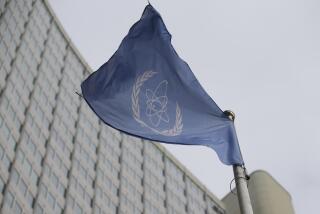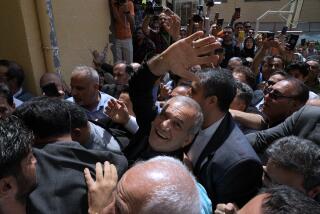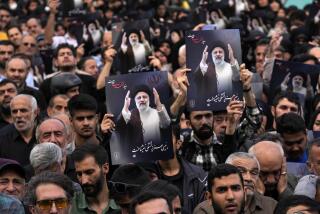Tehran sharing more nuclear data, agency says
CAIRO — Iran continues to expand its ability to enrich uranium, but is operating far below capacity and cooperating more fully in clearing up questions about its efforts, a U.N. report said Thursday.
According to the report by the International Atomic Energy Agency, Iran operates 1,968 centrifuges for producing enriched uranium that could ultimately be used to make nuclear weapons or generate electricity, a 50% increase over the number it had on line in April. However, the uranium has been enriched to only 3.7%, far less than the 90% estimated to be necessary for weapons-grade material.
In theory, about 3,000 centrifuges operating at full capacity for a year could produce enough material to make one bomb. Iran says it has mastered the technology and that a plant in the city of Natanz has the capacity to operate 50,000 centrifuges. Experts doubt these claims.
Iran insists that its nuclear program is meant to meet its civilian energy needs.
But U.S. and European officials suspect that Iran’s network of nuclear facilities masks a clandestine effort to obtain technology that could be used in the making of an atomic bomb. They have threatened to impose a fourth round of sanctions on Tehran when the United Nations Security Council takes up the issue again, probably next month.
The International Atomic Energy Agency, or IAEA, distributed copies of its report ahead of a Sept. 10 meeting of the organization’s 35-member board. The findings reflect an Aug. 21 agency agreement with Tehran that Iranian officials began publicizing several days ago. That accord said that there were “no other remaining issues and ambiguities regarding Iran’s past nuclear program and activities.”
“The work plan is a significant step forward,” the IAEA report says of last week’s agreement.
The report warns, however, that Iran needs “to continue to build confidence about the scope and nature of its present and future nuclear program.”
Iran shrugged off that caution and took the diplomatic offensive Thursday, highlighting its cooperation with the IAEA in apparent hopes of staving off further sanctions.
“The report emphasized once again that there exists no sign or evidence indicating diversion of Iran’s nuclear activities and that all Iran’s nuclear materials have been audited,” Ali Asghar Soltanieh, Iran’s representative to the IAEA, told Tehran’s Fars News Agency.
Assertions by Iranians and the U.N. nuclear watchdog agency that there were “no other remaining issues or ambiguities” outraged some nonproliferation experts, who said the IAEA was ceding too much to Iran.
“The idea of ‘closing files’ violates fundamental safeguards principles,” arms control experts David Albright and Jacqueline Shire, of the Washington-based Institute for Science and International Security, wrote in a criticism published this week.
“The agreement does not specify that Iran would provide the IAEA access to key people, facilities, and documents that are needed to verify Iranian answers to the IAEA’s questions.”
Most Western nonproliferation experts also said the latest agreement contained little that could dissuade key policymakers in Washington, London, Paris and Berlin from pushing forward with another round of Security Council sanctions.
Independent experts said Iran’s latest agreement with the IAEA, which gives inspectors access to more nuclear sites and information, fell well short of the West’s demand that Tehran halt the production of the concentrated uranium that could potentially be used for a bomb.
That concern was echoed Thursday by Bush administration officials.
Tom Casey, a State Department spokesman, said that although the report “may offer some new details or some new insight into how Iran’s program is developing, the fact of the matter is that they have not met any of their international obligations in this regard.”
Casey said the fact that the nuclear program continued to move forward “shows that the Iranian regime is continuing on a path of defiance of the international community.”
But the latest IAEA report could complicate U.S. efforts to pressure Iran. It says that Tehran “has been providing the agency with access to declared nuclear materials, and has provided the required nuclear material accountancy reports in connection with declared nuclear material and facilities.”
Many of the transparency issues reportedly resolved in last week’s agreement should have been untangled years ago, experts said. And the IAEA report cautions that the agency has been “unable to verify certain aspects relevant to the scope and nature” of Iran’s nuclear program.
“The agreement still does not address the fundamental problem: that Iran is pursuing an enrichment technology and capability that could put it within reach of making nuclear bomb material,” said Daryl Kimball, executive director of the Arms Control Assn., an advocacy group in Washington. “Iran’s design here is quite clearly to deflect criticism and pressure and to claim that progress is being made.”
Though Tehran has found few friends within the Security Council, which has voted unanimously to impose sanctions against Iran, the body’s penalties so far have been relatively painless, watered down from American demands under pressure from the Chinese and Russians.
Iran fears that the next round of sanctions could bite and has explicitly stepped up its cooperation with the IAEA to stave off the Security Council’s wrath. Iranian officials have repeatedly warned that they will reduce their collaboration with inspectors in the event of more sanctions.
The “report and the measures taken make the intervention of any other international organization, including the Security Council, irrelevant and unjustified,” Soltanieh said in an interview with state-controlled Iranian television.
--
Times staff writer Paul Richter in Washington contributed to this report.
More to Read
Sign up for Essential California
The most important California stories and recommendations in your inbox every morning.
You may occasionally receive promotional content from the Los Angeles Times.










